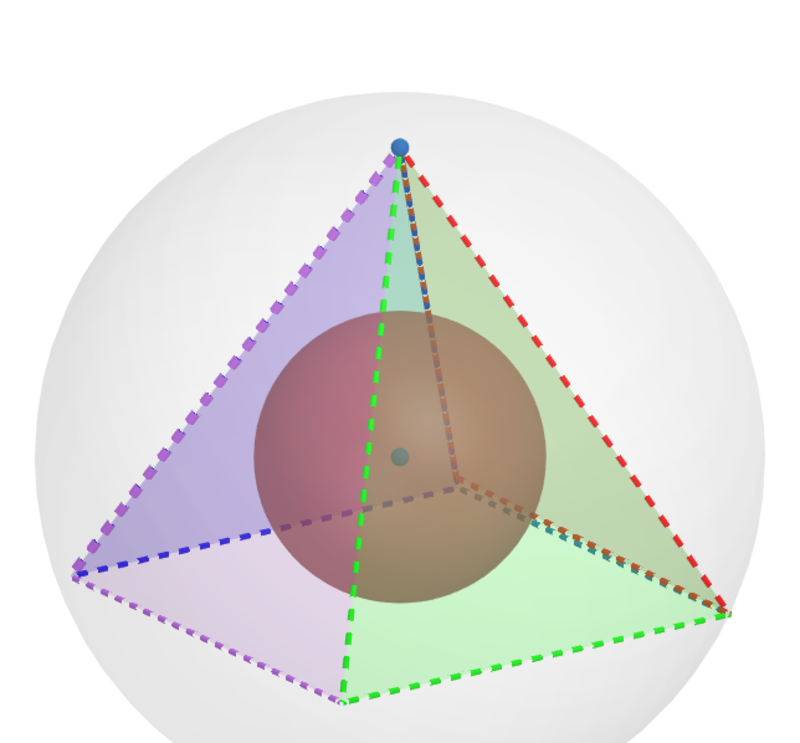Nested Square Pyramids and Spheres!

For each positive integer , let:
- be the volume of the largest square pyramid inscribed in a sphere of volume .
- be the volume of the largest sphere inscribed in the square pyramid of volume which is tangent to the faces of the square pyramid.
- .
If , where and are coprime positive integers and is the golden ratio, find .
The answer is 5.
This section requires Javascript.
You are seeing this because something didn't load right. We suggest you, (a) try
refreshing the page, (b) enabling javascript if it is disabled on your browser and,
finally, (c)
loading the
non-javascript version of this page
. We're sorry about the hassle.
V s ( 1 ) = 3 4 π R 1 3 and V p ( 1 ) = 3 1 x 2 2 H 1
Using the above diagram we have:
( H 1 − R 1 ) 2 + 2 x 1 2 = R 1 2 ⟹ x 1 2 = 2 ( 2 H 1 R 1 − H 1 2 ) ⟹ V p ( 1 ) = 3 2 ( 2 H 1 2 R 1 − H 1 3 ) ⟹
d H 1 d V p ( 1 ) = 3 2 H 1 ( 4 R 1 − 3 H 1 ) = 0 and H 1 = 0 ⟹ H 1 = 3 4 R 1 ⟹ x 1 = 3 4 R 1 = H 1 .
Let S = S 1 .
S 1 = 2 1 x 1 2 + 4 H 1 2 = 3 2 5 R 1
and the area of the blue triangle A = 2 1 x 1 H 1 = 2 x 1 + 2 S 1 R 2 ⟹ R 2 = x 1 + 2 S 1 x 1 H 1 = 3 4 ( 1 + 5 1 ) R 1 = 3 ϕ 2 R 1 , where ϕ = 2 1 + 5 .
H 2 = 3 4 R 2 = 9 ϕ 8 R 1 = x 2 and S 2 = 2 1 x 2 + 4 H 2 = 9 ϕ 4 5 R 1 ⟹
R 3 = x 2 + 2 S 2 x 2 H 2 = 9 ϕ 8 ( 1 + 5 ) 1 R 1 = 9 ϕ 2 4 R 1 = ( 3 ϕ 2 ) 2 R 1
In General:
R n = ( 3 ϕ 2 ) n − 1 R 1
Note: x n = H n = 3 4 ( 3 ϕ 2 ) n − 1 R 1 and S n = 3 2 ( 3 ϕ 2 ) n − 1 5 R 1
⟹ V s ( n ) = 3 4 π R n 3 = ( 2 7 ϕ 3 8 ) n − 1 ∗ V s ( 1 ) ⟹ T = ∑ n = 1 ∞ V s ( n ) =
V s ( 1 ) ∑ n = 1 ∞ ( 2 7 ϕ 8 ) n − 1 = 2 7 ϕ 3 − 8 2 7 ϕ 3 V s ( 1 ) = ( 3 ϕ ) 3 − 2 3 ( 3 ϕ ) 3 V s ( 1 ) ⟹
V s ( 1 ) T = ( 3 ϕ ) 3 − 2 3 ( 3 ϕ ) 3 = ( a ϕ ) a − b a ( a ϕ ) a ⟹ a + b = 5 .